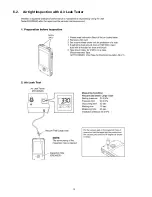
6
3 Service Navigation
3.1.
Introduction
This service manual contains technical information, which allow service personnel’s to understand and service this model.
Please place orders using the parts list and not the drawing reference numbers.
If the circuit is changed or modified, the information will be followed by service manual to be controlled with original service manual.
3.2.
General Description About Lead Free Solder (PbF)
The lead free solder has been used in the mounting process of all electrical components on the printed circuit boards used for this
equipment in considering the globally environmental conservation.
The normal solder is the alloy of tin (Sn) and lead (Pb). On the other hand, the lead free solder is the alloy mainly consists of tin
(Sn), silver (Ag) and Copper (Cu), and the melting point of the lead free solder is higher approx.30
°
C (86
°
F) more than that of the
normal solder.
Distinction of P.C.B. Lead Free Solder being used
Service caution for repair work using Lead Free Solder (PbF)
• The lead free solder has to be used when repairing the equipment for which the lead free solder is used.
(Definition: The letter of “PbF” is printed on the P.C.B. using the lead free solder.)
• To put lead free solder, it should be well molten and mixed with the original lead free solder.
• Remove the remaining lead free solder on the P.C.B. cleanly for soldering of the new IC.
• Since the melting point of the lead free solder is higher than that of the normal lead solder, it takes the longer time to melt the
lead free solder.
• Use the soldering iron (more than 70W) equipped with the temperature control after setting the temperature at 350±30
°
C
(662±86
°
F).
Recommended Lead Free Solder (Service Parts Route.)
• The following 3 types of lead free solder are available through the service parts route.
RFKZ03D01KS-----------(0.3mm 100g Reel)
RFKZ06D01KS-----------(0.6mm 100g Reel)
RFKZ10D01KS-----------(1.0mm 100g Reel)
Note
* Ingredient: tin (Sn) 96.5%, silver (Ag) 3.0%, Copper (Cu) 0.5%, Cobalt (Co) / Germanium (Ge) 0.1 to 0.3%
3.3.
Important Notice 1:(Other than U.S.A. and Canadian Market)
1. The service manual does not contain the following information, because of the impossibility of servicing at component level
without concerned equipment/facilities.
a. Schematic diagram, Block Diagram and P.C.B. layout of MAIN P.C.B..
b. Parts list for individual parts for MAIN P.C.B..
When a part replacement is required for repairing MAIN P.C.B., replace as an assembled parts. (Main P.C.B.)
2. The following category is /are recycle module part. Please send it/them to Central Repair Center.
• MAIN P.C.B.
Summary of Contents for HM-TA20EB
Page 8: ...8 4 Specifications ...
Page 9: ...9 ...
Page 12: ...12 6 Troubleshooting Guide 6 1 Confirmation Flow of Waterproof ...
Page 13: ...13 6 2 Airtight Inspection with Air Leak Tester ...
Page 14: ...14 6 3 Air Leak Tester RFKZ0528 Operating Instruction ...
Page 15: ...15 ...
Page 16: ...16 ...
Page 17: ...17 ...
Page 21: ...21 8 3 1 Removal of the Battery Fig D1 Fig D2 Fig D3 ...
Page 22: ...22 Fig D4 8 3 2 Removal of the LCD Fig D5 ...
Page 24: ...24 8 3 6 Removal of the Main P C B Fig D10 8 3 7 Removal of the USB Unit Fig D11 ...
Page 26: ...26 Fig D14 Fig D15 ...
Page 27: ...27 8 3 10 Removal of the CCD Unit Fig D16 Fig D17 ...
Page 28: ...28 8 3 11 Removal of the Front Case Unit Fig D18 Fig D19 ...
Page 31: ...31 10 Maintenance 10 1 Regular Maintenance Flow ...
Page 32: ...32 10 2 Component Kits of Waterproof ...
Page 35: ...35 12 Exploded View and Replacement Parts List 12 1 Exploded Views ...
Page 36: ...36 ...







































